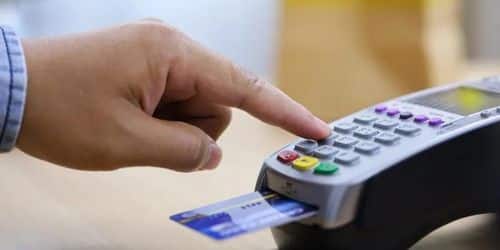EMV Chip began as a collaboratively established global standard that permits interoperability between cards with computer chips and terminals used by the world’s leading financial institutions. Nowadays, EMV is a technology kit that enables secure payment in both face-to-face and distant situations. The standard is presently controlled by EMVCo, a global technology group that manages and evolves the EMV Specifications and related testing processes to allow global interoperability and acceptance of secure payment transactions. Here’s all you need to know about EMV cards and how they work.
What is EMV?
EMV is the payment technology used by all credit and debit cards that include an integrated chip that allows the cardholder to make a more secure transaction. “EMV” stands for “Europay, Mastercard, and Visa,” the businesses that created EMV payment technology in 1994. EMVCo, an organization comprised of Mastercard, Visa, American Express, Discover, JCB, and UnionPay, now manages EMV technology. As a result, EMV technology has become the industry standard for all of the world’s largest card networks.
What You Should Know About EMV
Security advantages: EMV cards are more secure than magnetic stripe cards, which is one of the reasons why the United States – and much of the rest of the world – has made the changeover.
Late adoption: The United States did not begin to implement EMV until recently, with the biggest movement driven by a 2015 change to payment fraud liability regulations.
Merchant liability: Merchants without EMV-compliant card readers may be held accountable for fraudulent transactions with EMV-enabled cards.
Status in 2023: The United States has migrated nearly all of its payment cards to EMV technology, and the majority of merchants have EMV-enabled readers.
How Does EMV Work?
EMV is based on payment cards (credit and debit) with an embedded computer chip, as well as special card readers designed to scan those chips. The computer chip allows for more encryption and security than a card with merely a magnetic stripe that you swipe. Because the chip provides a unique code for each transaction, counterfeit EMV credit cards are nearly impossible to create.
EMV credit cards are classified into two types: chip-and-PIN and chip-and-signature. A chip-and-PIN card, as the names suggest, employs a PIN you establish to confirm your transaction, but a chip-and-signature card requires you to sign your name. Chip-and-PIN cards are more secure since it is easier to impersonate a signature than it is to guess a PIN.
However, because not every retailer has a credit card reader that can read chips, all EMV cards in the United States also have the classic magnetic stripe. When you swipe, you give up the extra protection provided by EMV technology.
While the technology behind EMV credit cards is fairly complex, using one is actually rather straightforward.
How to Make Use of an EMV Card
- Request that the vendor ring up your purchase.
- Insert the end of your card with the chip facing up into the reader.
- Depending on the card, enter your PIN or provide your signature.
- Complete the transaction.
- When prompted, remove your card.
Contactless payment readers can also be enabled for EMV cards. Instead of dipping or swiping the card, you simply tap it against an NFC (near field communication) scanner.
Advantages of EMV
#1. Security
EMV chips are more secure than magnetic stripes and generate unique transaction codes that cannot be reused.
#2. Universality
Credit cards with EMV chips can still be used at merchants without EMV terminals. Instead, you can simply swipe the card’s magnetic stripe.
#3. International use
International EMV credit cards are often chip-and-pin. However, unlike a card with merely a magnetic stripe, you can use a chip-and-signature card at most overseas retailers without trouble. The only exceptions are automatic kiosks and gas pumps, which may require a chip-and-pin card or cash.
#4. Contactless
EMV cards can accept contactless payments, albeit the percentage of EMV cards that do so is still modest. It is up to the card issuer whether or not to include contactless functionality.
#5. Offline
Certain chip-and-pin cards feature offline transaction verification, allowing transactions to be made without the need for an internet connection. This is not possible with older card readers or magnetic stripe cards.
The Best EMV Credit Cards
- Best Overall: Chase Freedom Unlimited®
- Cash Back: Wells Fargo Active Cash® Card
- Good Credit: Blue Cash Preferred® Card from American Express
- Fair Credit: Upgrade Cash Rewards Visa®
- Beginners: Petal® 2 Visa® Credit Card
- Best Rates: Wells Fargo Reflect® Card
The Capital One Venture Rewards Credit Card is the finest EMV chip credit card since it is a chip-and-PIN card with fantastic travel rewards, no foreign transaction fee, and worldwide acceptance. The Capital One Venture Rewards Credit Card offers 2 – 5 miles for every $1 spent on purchases, plus a 75,000-mile sign-up bonus after spending $4,000 in the first three months.
EMV In The US
The United States was slower to implement EMV technology than many other nations, but when it comes to payment cards, we’ve just about completed the shift in the last few years. Merchants have lagged behind card issuers in adopting the technology, despite the fact that failure to upgrade places the retailer at risk of fraud.
Credit and Debit cards with EMV Technology
Almost all credit and debit cards in the United States are now EMV-compliant. That amounts to approximately 1 billion cards in all. EMV cards now account for almost 99% of the total payment volume in the United States. This is a remarkable leap from the 1.6% recorded in 2015, demonstrating how quickly the United States has shifted.
Nonetheless, EMV in the United States remains distinct from the rest of the world. In the United States, debit cards are often chip-and-PIN, whereas credit cards are typically chip-and-signature. Outside of the United States, chip-and-PIN credit cards are more common.
Furthermore, according to Visa, about 175 million EMV cards in the United States will support contactless payments by 2023. That’s still a modest number when compared to the 1 billion EMV cards in use in the United States, but the technology is expected to grow more popular in the future. Chase, American Express, Capital One, Citi, Discover, and U.S. Bank are among the companies that have begun to provide contactless cards.
EMV for Retailers
According to Visa, almost 75% of businesses in the United States – a total of over 3.5 million merchants – have EMV terminals. While this is a significant increase from the fewer than 400,000 merchants who had EMV-compatible scanners in 2015, it remains low when considering that practically all cards employ EMV technology.
Merchants who do not switch to EMV readers risk losing money if they are found liable for fraudulent purchases. EMV terminals can be costly, often costing a few hundred dollars per, but the investment is worthwhile in the long run. Nevertheless, small businesses should examine options such as using low-cost EMV readers from companies such as Square to handle transactions (though there are transaction fees to watch out for).
What is an EMV Chip, and How Does it Keep Your Information?
Many new credit and debit cards include EMV chips, which replace the magnetic stripe on the back of the card with a more secure data-storage mechanism. Several establishments now ask customers to use the EMV chip instead of swiping their cards to pay.
What Exactly is EMV Chip Technology?
Instead of a magnetic stripe, EMV cards store cardholder information on a metallic chip. Only special readers can authenticate these chips, making them more secure than stripe-only cards.
The key advantage of EMV chip technology is the prevention of counterfeit fraud. Counterfeit fraud, in which a cardholder’s information is taken, stored, and reprinted on a new card, has dropped dramatically since the introduction of EMV chip technology.
According to Visa, counterfeit fraud decreased 76% among shops that used EMV card readers between 2015 and 2018.
How do EMV Chip Cards Function?
One of the primary advantages of EMV chip technology is that it protects cardholders’ credit card information. When placed into an EMV reader, these chips generate a one-time-use code, which is used to process payments instead of the card number printed on the card.
When you use an EMV card to make a purchase, the merchant never obtains or communicates your real card number. This makes it far more difficult for criminals to forge their card.
Tokenization is the act of emulating a card number, and it is becoming more popular as a method of safeguarding sensitive payment data. Tokenization is also used for more secure payments in so-called contactless technologies such as Apple Pay, Google Pay, and Samsung Pay.
What if a business does not take EMV cards?
Although not all merchants have EMV readers installed, the number of those that do is gradually increasing. In March 2019, Visa stated that 75% of US shops accept EMV cards, up from 50% just two years previously.
If you make a non-EMV purchase, the retailer can still swipe your card the old-fashioned manner. However, because this is less secure, the merchant may be held accountable for any fraudulent transactions that result from a card swipe. To avoid this responsibility, many merchants are implementing EMV readers.
Best Practices for Card Security
Searching out establishments that accept EMV cards is a good first step, but there’s more you can do.
Be cautious when shopping online. With the fall of in-person counterfeit purchases, credit card theft has switched to the internet. Always enter your credit card information online if you are convinced that the storefront is real.
Never give out your card number to persons you know and trust. Take every effort to protect your card number, such as not writing it down anywhere and keeping it a secret. If you must share your credit card on a frequent basis with trusted friends or family members, consider adding these people as authorized users on their own credit cards.
Check to see if your card issuer provides one-time-use card numbers. If your card issuer allows it, you may be able to “tokenize” your credit card number yourself. Check with your issuer to see if single-use card numbers are available.
Examine your credit card bills — and your credit report — on a frequent basis. Examine your statements at least once a month and be wary: you usually only have 60 days to contest a fraudulent claim. Remember that you are entitled to three free credit reports each year, which can help you ensure that your report is accurate.
Account safety and security with EMV cards
EMV cards can help to improve the security of routine credit card transactions. To maximize the security of your credit card account, make purchases from businesses that utilize EMV readers and keep a tight check on your transaction history.
What Does EMV Stand For?
EMV is an acronym that stands for Europay, Mastercard, and Visa, the three corporations that developed the EMV standard.
Can EMV Cards Be Cloned?
EMV chips cannot be cloned. Fraudsters, however, can build a functional card clone by copying data from the card’s chip and transferring it to a magnetic stripe card.
Can EMV Cards Be Hacked?
Yes, in general. Because all personal information is encrypted and tokenized for each transaction, chip cards are safer and more secure than standard credit cards with simply magnetic stripes. There are, however, technologies that allow criminals to obtain EMV chip information.
In Conclusion
Credit card security is improving, and EMV chips play a crucial role in that progress. Yet, it’s crucial to remember that you’re never fully risk-free. While in-person transactions using chip cards are generally safer, fraudsters may resort to more vulnerable card-not-present transactions, such as online or phone purchases, to continue to defraud consumers.
If you are the unfortunate victim of credit card fraud, your liability is limited to $50 under the Fair Credit Billing Act. That’s wonderful news, but the sense of having your credit and personal information violated may be more difficult to overcome than a $50 loss.
When analyzing your credit card statements, keep an eye out for fraud and report anything that appears suspicious.
Related Articles
- Chip Brands: 2023 Top Most Popular 21 Brands (Updated)
- POTATO CHIP BRANDS: 2023 List of the Oldest Potato Chip Brands (Updated)
- BLUE CHIP STOCKS: Meaning, Characteristics & How to Invest
- How to Start an ATM Business: Is it Profitable or Not?






